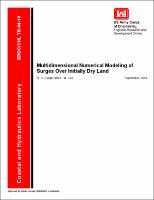Please use this identifier to cite or link to this item:
https://hdl.handle.net/11681/7586Full metadata record
| DC Field | Value | Language |
|---|---|---|
| dc.contributor.author | Berger, Rutherford C. | - |
| dc.contributor.author | Lee, L. M. | - |
| dc.date.accessioned | 2016-05-06T14:33:29Z | - |
| dc.date.available | 2016-05-06T14:33:29Z | - |
| dc.date.issued | 2004-09 | - |
| dc.identifier.uri | http://hdl.handle.net/11681/7586 | - |
| dc.description | Technical report | - |
| dc.description | For modelers evaluating the impact of dam, levee, and structure failures the need is to be able to determine the flood height and timing. A two-dimensional (2-D) model needs to be able to reproduce this flood wave along the channel and over dry ground. This report details the testing of the 2-D shallow-water module of the ADaptive Hydraulics (ADH) model for surges over initially dry ground. ADH utilizes an unstructured computational mesh that is automatically refined. Other modules in ADH include three-dimensional (3-D) Navier Stokes (with and without the hydrostatic pressure assumption) and groundwater flow. Testing is conducted in comparison to physical flume results for two test cases. The first test case is for a straight flume and the second contains a reservoir and a horseshoe channel section. It is important that the model match the timing of the surge as well as the height. In both cases the ADH compared closely with the flume results. | - |
| dc.publisher | Coastal and Hydraulics Laboratory (U.S.) | - |
| dc.publisher | Engineer Research and Development Center (U.S.) | - |
| dc.relation | http://acwc.sdp.sirsi.net/client/en_US/search/asset/1000737 | - |
| dc.relation.ispartofseries | ERDC/CHL TR ; 04-10. | - |
| dc.rights | Approved for public release; distribution is unlimited. | - |
| dc.source | This Digital Resource was created from scans of the Print Resource. | - |
| dc.subject | Two-dimensional | - |
| dc.subject | Finite element | - |
| dc.subject | Flooding | - |
| dc.subject | Flume | - |
| dc.subject | Surge | - |
| dc.title | Multidimensional numerical modeling of surges over initially dry land | - |
| dc.type | Report | en_US |
| Appears in Collections: | Technical Report | |
Files in This Item:
| File | Description | Size | Format | |
|---|---|---|---|---|
| CHL-TR-04-10.pdf | 350.54 kB | Adobe PDF |  View/Open |